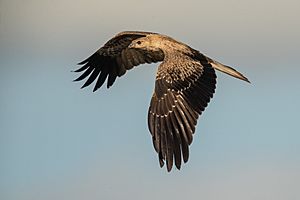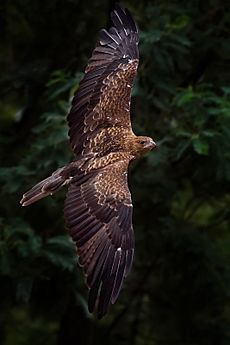Whistling kite facts for kids
Quick facts for kids Whistling kite |
|
|---|---|
 |
|
| Conservation status | |
| Scientific classification | |
| Genus: |
Haliastur
|
| Species: |
sphenurus
|
The whistling kite (Haliastur sphenurus) is a medium-sized bird of prey that flies during the day. It lives across Australia, New Caledonia, and much of New Guinea. This bird is also known as the whistling eagle or whistling hawk. It gets its name from its loud whistling call, which it often makes while flying.
Contents
About the Whistling Kite
Whistling kites are usually between 50 and 60 centimeters (20–24 inches) long. Their wingspan can be from 123 to 146 centimeters (48–57 inches). They weigh between 380 and 1050 grams (13–37 ounces).
Like most birds of prey, the female whistling kites are bigger and heavier than the males. Females can be up to 21% larger and 42% heavier. Birds living in the southern parts of their range are also larger than those in warmer, tropical areas.
Both male and female birds have the same colors. Adult kites have a light, creamy color on their head, chest, and tail. Their wings are browner, and their flight feathers are black. Young birds are reddish-brown with streaks and light spots on their wings. All whistling kites have bone-colored legs and feet that are not covered in feathers.
When perched, the whistling kite looks like it has a small head and a long tail. Its wingtips do not reach the end of its tail. Even though its legs are short, the bird can walk easily on the ground. When flying, whistling kites soar with their wings slightly bent. Their long flight feathers often spread out like fingers. The unique pattern under their wings helps to identify them.
What Does a Whistling Kite Sound Like?
This bird is quite noisy and often calls while flying or sitting. It even calls when it is at its nest. Its most common call is a clear whistle that goes down in pitch. This is often followed by a quick series of rising notes.
Scientists have found that spotted bowerbirds sometimes copy the calls of whistling kites. They do this more often as the breeding season gets closer. We don't know why they do this.
Where Whistling Kites Live
Whistling kites live in open areas or places with light woods. They are usually found near water, from sea level up to 1400 meters (about 4600 feet) high.
Most whistling kites stay in one area. However, some Australian birds travel around. They might go to coastal areas in northern Australia during the dry season. Some birds in southern Australia fly south in the autumn. There are signs that their numbers are decreasing in southern Australia. This is because wetlands are being drained, which means less food for them.
How Whistling Kites Behave
Whistling kites are usually seen alone or in pairs. But sometimes, they gather in larger groups. This happens when they are traveling, resting together, or when there is a lot of food.
What Whistling Kites Eat
Whistling kites eat many different things. They catch small mammals, birds, fish, reptiles, amphibians, crustaceans, and insects. They also eat carrion, which is dead animals.
In Australia, they mostly hunt live prey. But in winter, they eat a lot of carrion. In New Guinea, they are mainly scavengers, meaning they mostly eat dead animals. They usually grab food from the ground or the water's surface. Sometimes, they catch insects right out of the air.
Whistling kites are known to steal meals from other birds like ibises and herons. They also steal from other birds of prey. They might even make large waterbirds throw up the fish they have caught. These kites often fly along roads looking for animals hit by cars. They also hover over grass fires to catch animals trying to escape the flames. When food is hard to find, they rely almost completely on finding carrion.
Reproduction and Life Cycle
The whistling kite builds a large nest out of sticks. It lines the nest with green leaves. The nest is usually placed in a tall tree fork, often in a eucalypt or pine tree near a river.
Pairs often use the same nest year after year. They add more material each year, making the nest quite big. The female usually lays 2 or 3 bluish-white eggs. These eggs sometimes have reddish-brown spots. They can lay between 1 and 4 eggs.
The eggs are kept warm for 35 to 40 days. About 60% of the eggs hatch. The baby chicks are covered in cream-colored or buff-colored down feathers. They stay in the nest for 44 to 54 days before they can fly. After leaving the nest, they still depend on their parents for another 6 to 8 weeks.
In Australia, these birds usually breed between June and October in the south. In the north, they breed between February and May. However, they can nest at any time after it rains, as long as there is enough food.
Images for kids
See also
 In Spanish: Milano silbador para niños
In Spanish: Milano silbador para niños





